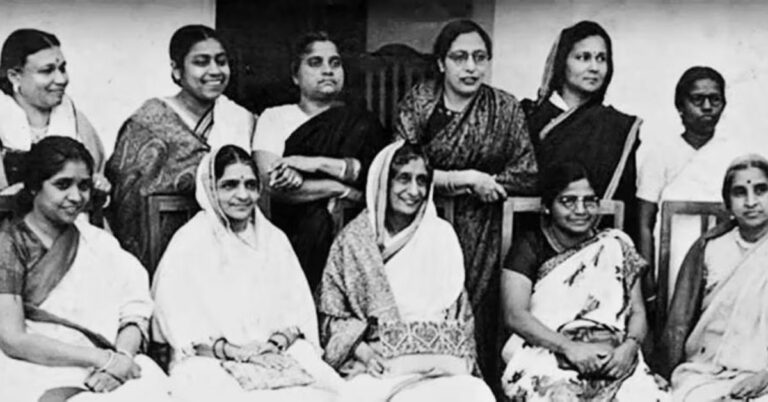Before hashtags, court rallies, or Women’s Day discounts, India quietly made room for feminism in its rulebooks. At a time when women didn’t have voting rights in many countries and were still considered second to men in most parts of the world, India, yes, colonised, chaotic, caste-ridden India, passed laws that fiercely protected a woman’s right to dignity, choice, and even rebellion.
Some of these laws were buried in dusty legal texts, some emerged from fiery reformers and some were quietly radical, chipping away at patriarchal norms long before feminism became a buzzword.
Here are five surprisingly progressive, feminist-leaning laws that were way ahead of their time.
Advertisement
The small steps taken to provide women an identity and security started long before independence. Picture Source: CWDS Archives
1. The Hindu Widows’ Remarriage Act
When: 1856
Where: Across British India for Hindus
In 1800s India, if your husband died, society expected you to become invisible. You were stripped of colour, joy, and agency. Widows were considered inauspicious and often forced into a life of isolation, sometimes even child widows as young as eight or nine.
Then came Ishwar Chandra Vidyasagar, a reformer from Bengal who refused to accept this cruelty as “tradition.” He lobbied the British, rallied public opinion, and eventually succeeded. The 1856 law legally allowed Hindu widows to remarry — something that was almost unthinkable at the time.
This wasn’t just about marriage. It was about giving women a second chance at life. A radical concept back then — still powerful today.
2. The Married Women’s Property Act
When: 1874
Advertisement
Where: British India
Here’s the thing: before this law, once a woman got married, anything she owned — money, land, jewellery, automatically belonged to her husband. She couldn’t sell it, invest it, or use it independently.
This Act changed that. It legally recognised a married woman’s right to hold property in her own name. She could now have legal ownership over her earnings and belongings, even while being married.
It was an early attempt to say: a woman isn’t an extension of her husband. She has a legal identity. She can earn, own, and control. A quietly radical move for a society that didn’t even think women needed bank accounts.
3. The Child Marriage Restraint Act (Sarda Act)
When: 1929
Where: All of British India
Advertisement
Child marriage was not just common — it was the norm. Girls were married off before they even hit puberty. The Sarda Act, named after judge and reformer Harbilas Sarda, was India’s first real attempt to put an age limit on this practice.
Child marriage was abolished by a law that faced a lot of criticism. Picture source: garystockbridge
It made it illegal for girls under 14 and boys under 18 to marry (later raised to 18 and 21). Of course, implementation was patchy. But the message was clear: girls were not commodities to be handed over like dowry items. They deserved a childhood.
This law planted the seed for future reforms and was the beginning of the government stepping into personal, cultural territory — something that wasn’t easy then, and still isn’t now.
4. The Hindu Succession Act
When: 1956, Amended 2005
Where: Post-independence India for Hindus, Buddhists, Jains & Sikhs
Ask any woman from the ‘80s or ‘90s about inheritance, and chances are she’ll say, “My brother got everything.” Before 1956, women in Hindu families were not legal heirs to joint family property. That meant land, ancestral homes, and farmland — all went to the sons.
Advertisement
The 1956 law made daughters legal heirs for the first time. But even then, the right wasn’t equal, especially if the father was still alive. It was only with the 2005 amendment that the law went further, declaring daughters as coparceners — equal in rights and duties.
In plain terms: if your brother gets land, you get land. No questions. No conditions.
5. The Dissolution of Muslim Marriages Act
When: 1939
Where: British India (for Muslims)
This one is often overlooked, but it’s quietly one of the most empowering. It gave Muslim women the right to legally divorce their husbands — something that was historically much easier for men via talaq.
The law listed specific grounds: cruelty, impotence, desertion, non-payment of maintenance, and even failure to perform marital obligations. This wasn’t about ending marriage lightly — it was about giving women the legal tools to walk away from abuse or neglect.
Advertisement
The laws were able to carve a place for women in society – a respectable one. Picture source: garystockbridge
In a time when divorce carried heavy stigma, this law handed Muslim women a voice in their own futures. A huge shift, especially considering how few global legal systems allowed this at the time.
These laws didn’t magically fix everything. They didn’t dismantle patriarchy overnight or make Indian society suddenly gender-equal. But they did something just as powerful — they carved space for women in a legal system that had long ignored them.
And each time a girl goes to school instead of getting married, a woman owns land in her name, or a widow finds love again — we’re living the legacy of these forgotten feminist laws.

